Traveling around Thessaloniki with a local
I was born and raised in Thessaloniki (also called Thessalonica), the largest city in the Greek region of Macedonia and the second-largest city in Greece. Since I moved to England at the age of 23, I come back to my hometown several times a year, and each time I’m pleasantly surprised, as there’s always something new to discover. Today, I would like to take you to a tour around the city, including some of my favorite hangouts as well as new hotspots.
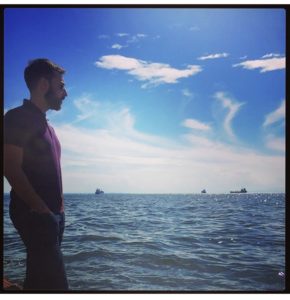
About Thessaloniki
Thessaloniki is a coastal city located on the Thermaic Gulf, at the northwest corner of the Aegean Sea. Founded over two millennia ago, the city has a long, rich and diverse history. Since early on, Thessaloniki has played an important role in the region and beyond. It has been a regional capital of the Roman Empire, as well as one of the most important cities of the Byzantine Empire, second only to Constantinople. Like the rest of Greece, Thessaloniki was under Ottoman rule for a long part of the second millennium AD, and it was only a century ago (in 1912) when it was annexed to Greece (about 80 years after the independence of the country).
Nowadays, Thessaloniki is a vibrant city, home to close to one million people (a little over one million, if we are talking about the metropolitan area, which also includes a few towns and villages around the city). Like most Greek cities, Thessaloniki is densely-populated; most people live in flats, rather than houses, both in the city center and the suburbs, and there are very few open spaces and parks. In the past, there used to be many neoclassical townhouses; unfortunately, most of them have been destroyed and only a few are left to admire today.
Around Thessaloniki
The city center
There are several reasons why the city center, sometimes referred to as the historic center, is my favorite part of Thessaloniki. First, most of the city’s landmarks and places of historical and cultural interest are located here. Second, this is also the commercial center of the city, full of shops, restaurants, cafes and bars. Third, it is very pleasant to walk around, from the waterfront to the small streets and the hidden arcades.
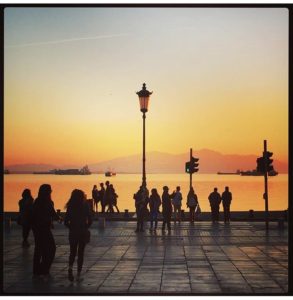
The city center is a rocket-shaped area, sandwiched between the seafront (Leoforos Nikis/Nikis Avenue) on the one side and Agiou Dimitriou Str. on the other. To complete the rocket shape, we need a base (Tritis Septemvriou Str.) and a triangle on the opposite end (Dodekanisou Str. and Karaoli ke Dimitriou Str. acting as the free sides of the triangle). The rocket points towards the railway station, located to the west of the city center.
The waterfront of the city center (Paralia)
The waterfront of the city center (Paralia in Greek) stretches between the port and the White Tower, the most iconic landmark of the city. The cylindrical monument served as a prison when Thessaloniki was under Ottoman rule; nowadays, it houses a museum about the more recent history of the city.
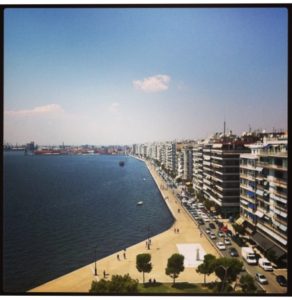
On the opposite end of the seafront, near the port, there’s the picturesque district of Ladadika. Once a red-light district, it is now a pedestrianized heritage site, home to many restaurants, cafes and bars.
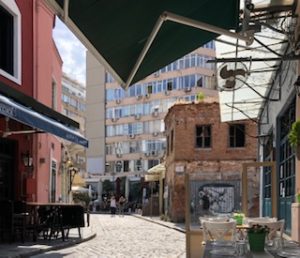
Between the port and the White Tower (but closer to the former and to Ladadika), there’s Aristotelous Square, the main square of the city, surrounded by listed buildings dating to the beginning of the 20th century, and many cafés. The square is named after the ancient Greek philosopher Aristotle, who was born in Stagira, an ancient city located in the peninsula of Halkidiki, about an hour’s drive from Thessaloniki.
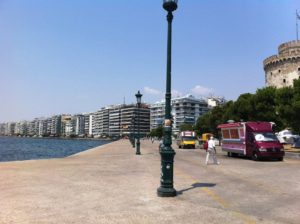
The monuments of the city center
The pedestrianized Aristotelous Str. connects Aristotelous Square with Dikastirion Square and the Ancient (or Roman) Agora, a two-terraced Roman forum dating to the 2nd century AD. One of my favorite churches, the 11th-century Byzantine Church of Panagia Halkeon, is right there and is certainly worth a visit.
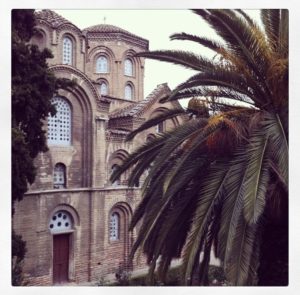
In fact, there are many notable churches in the city center, many of which have been listed as UNESCO World Heritage Sites. So far, a total of 15 Paleochristian and Byzantine monuments have been listed as such (more than in any other Greek city), and most of these monuments are churches. Amongst those, the Church of Agios Dimitrios (Saint Demetrius), Patron Saint of Thessaloniki, is one of the most significant. Not far from this basilica, which dates to the 7th century AD, there’s the Church of the Ahiropiitos, a 5th-century Byzantine church dedicated to the Virgin Mary. The Rotunda is even older; it is actually the oldest of the city’s churches. This round-shaped building is nowadays a historical monument, also worth a visit. So does the Church of Agia Sophia, dating to the 8th century.
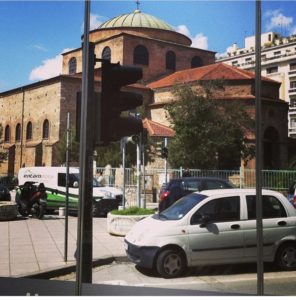
Also located in the city center are the Arch of Galerius (also known as Kamara), and the remains of the imperial palace complex which the Roman emperor commissioned when he made the city the capital of his portion of the Roman Empire. These are located on the pedestrianized Dimitriou Gounari Str. and at Navarinou Square.
All these monuments and places are located within walking distance from each other; you only need a few hours to visit them all, unless of course you combine your visit with a coffee or a meal. In fact, the city center is scattered with hundreds of cafes, restaurants and bars, popular with locals all day (and night) long (keep reading for my recommendations).
The Walls and the Upper Town (Ano Poli)
The Walls surrounded the city from the Middle Ages until the late 19th century, when part of the Walls was demolished. Therefore, nowadays, only parts of the Walls still exist; a part can be found in the city center, and another part in Ano Poli (Upper Town), built on a hill north of the city center. Unlike most of the city center, which was destroyed by the great fire of 1917 and is now dominated by 20th century—built blocks of flats, the Upper Town still has many traditional houses.
The museums
The city’s rich history is reflected not only in the surviving buildings and monuments, but also in its many museums. Amongst those, my favorites are the Archaeological Museum of Thessaloniki and the Museum of Byzantine Culture. They’re located almost next to each other, on the edge of the city center, close to the University Campus, the City Hall, and the International Exhibition Center, permanent venue of the Thessaloniki International Fair, which takes place every September.
The Archaeological Museum exhibits findings dating to the Prehistoric, Archaic, Classical, Hellenistic and Roman periods. These findings were excavated in Thessaloniki and elsewhere in Macedonia.
The Museums of Byzantine Culture (sometimes referred to as the Byzantine Museum) exhibits findings dating from the 2nd to the 20th century AD.
The waterfront on the southeast of the city center (Nea Paralia)
My parents’ home is located outside of the city center, in a suburb called Depot. It is only a few minutes away (on foot) from the Concert Hall (Megaro Mousikis), a modern complex located on the seafront, on the southeast of the city center. From there, I often walk along the waterfront towards the White Tower and the city center; the 2-mile (3 km) walk takes me about 40 minutes, depending on how many photos I’ll take on my way.
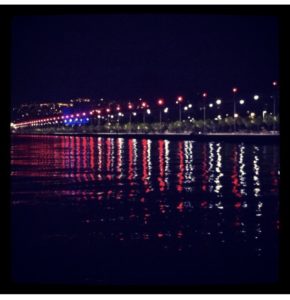
I particularly enjoy this walk in the evening, since the seafront is a perfect place to watch the sunset. As such, the seafront is popular with the locals as well as the visitors. To add to its charm, this part of the waterfront (called New Paralia) is scattered with many statues and sculptures, the most impressive being the instagrammable Umbrellas and the equestrian statue of Alexander the Great. There are also quite a few buskers and vendors selling refreshments, as well as a couple of bar-restaurants such as Omilos Bar Restaurant, Ciel Bar and Navona Day & Night. The latter is located on the grounds of the iconic Macedonia Palace Hotel.
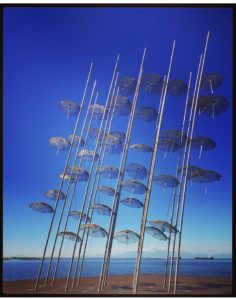
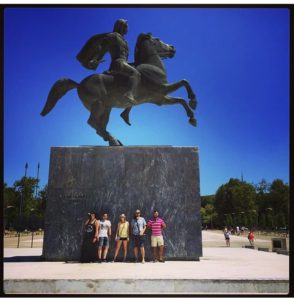
To the visitors, I would recommend setting off from the city center, i.e. from anywhere between the port and the White Tower, and walking along the seafront towards the Concert Hall, where there is a rooftop bar (Allegro), a perfect place to finish off the day. There’s also an open-air cinema there, open during the summer months.
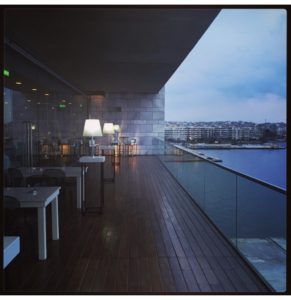
What to do in Thessaloniki
Once you’ve walked around Thessaloniki and visited some of the museums, it is time to dive into the contemporary culture of the city.
Thessaloniki International Film Festival (TIFF)
For the last 60 years, Thessaloniki has been home to an annual film festival that takes place every November and attracts Greek and international filmmakers and film enthusiasts. The 61st Thessaloniki International Film Festival is due to take place from 5 to 15 November 2020. Due to the COVID-19 pandemic, this year’s edition will be a hybrid with screenings and events in theaters, online and in public spaces.
Open-air cinemas
If you visit Thessaloniki during the summer or in September, you should definitely try to watch a film (either a recent release or a classic) in an open-air cinema. Foreign films are almost always subtitled in Greek; the only exception is animation films, which are often dubbed in Greek. My favorite open-air cinemas are Cine Natali (almost on the seafront, close to the Umbrellas) and Cine Ellinis (right next to the International Exhibition Center).
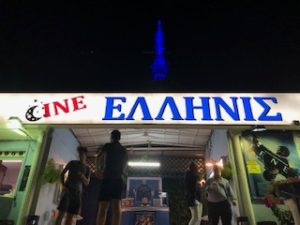
Summer festivals
Film screenings aside, there are many other open-air cultural events (music concerts and plays), taking place in the summer months and in September. These cultural events are usually part of a summer festival; for example, the Forest Festival (Festival Dasous) takes place at the Forest Theater (Theatro Dasous), whereas the Moni Lazariston Festival and the Festival Eptapyrgiou take place at the courtyard of the Lazaristes Monastery (Moni Lazariston). Unfortunately, many events have been canceled this summer due to the COVID-19 pandemic. The Trojan Women by Euripides is on at the Forest Theater until 24 September 2020, whereas Eleonora Zouganeli, one of my favorite Greek singers, gave a concert yesterday at the Lazaristes Monastery. This concert was originally planned to take place in August, but was postponed due to the weather conditions.
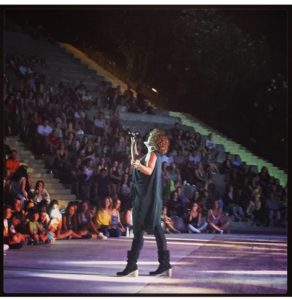
Eating and drinking in Thessaloniki
Nowadays, Thessaloniki is considered Greece’s gastronomic capital, a culinary paradise. Here are some of my favorite places to eat and to drink.
Breakfast – brunch
Let’s start with breakfast. If there is one thing you absolutely need to try whilst in Thessaloniki, this is bougatsa, a traditional breakfast pastry made with phyllo and usually filled with custard (there are also savory fillings). It actually originates from the nearby town of Serres, about an hour away from Thessaloniki. Bakeries are the best places to try bougatsa, as well as koulouri. This is a delicious Eastern Mediterranean bread, either circular or straight, encrusted with sesame seeds, and served in the morning. Unlike bougatsa, koulouri is often sold by street vendors in the city center. You should also try tsoureki, a sweet bread seasoned with mastic and mahlab, sometimes covered with chocolate. Best to try it at Terkenlis (67, Mitropoleos Str; 30 Tsimiski Str.; 33, Agias Sofias Str.).

For brunch, one of my favorite places is Estrella, located opposite the Church of Agia Sophia (48, Pavlou Mela Str.). Although it is renowned for their pancakes, I particularly enjoy their bougatsan, a unique hybrid between a croissant and a bougatsa.

Coffee
Greeks tend to prefer coffee over tea, but when it is hot, coffee has to be iced. Thessaloniki is renowned as the birthplace of frappé coffee, made with instant coffee shaken with water, then poured over ice cubes, topped with milk and cold water. Irrespectively of the weather and the temperature of the beverage, coffee is best enjoyed in the company of friends, preferably in a cozy café.
Fortunately, the city center is full of inviting cafés and coffeehouses. For a more authentic experience, I would avoid the coffeehouse chains, either Greek or international. Although I do not have a personal favorite (at the end of the day, there are so many cafés that it is almost impossible to choose one), I prefer those on Karolou Ntil Street, close to the intersection with Mitropoleos Str. Another favorite café of mine is Tabya, housed in a neoclassical townhouse near Rotunda and opposite the University Campus (14, Melenikou Str.).
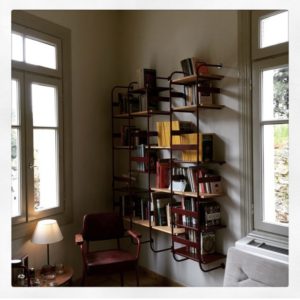
Although it is highly unlikely that you will arrive to Thessaloniki by sea, and even if you don’t visit the city in November, when the TIFF takes place (some TIFF screenings take place at the port), we may still visit the port together. The reason is simply to have a coffee or even a drink at Kitchen Bar, an all-day cafe-bar-restaurant facing the waterfront of the city center.
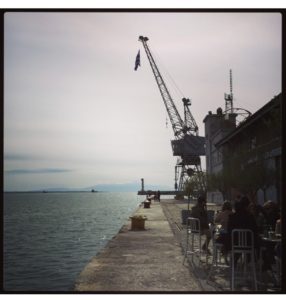
Alternatively, you can enjoy a coffee or a drink at High School Pizza Bar on the seafront, only a few meters away from Aristotelous Square (9, Leoforos Nikis). As the name suggests, they also serve food (Italian cuisine).
Restaurants
From there, you could walk to nearby Ladadika, and perhaps have a meal there. There are many restaurants and taverns, Zithos being my favorite (5, Katouni Str.).
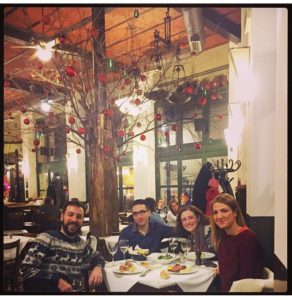
Alternatively, you can walk along the waterfront towards the White Tower, and have a meal either at the second location of Zythos (just opposite the landmark monument, 7, Tsirogianni Str.) or at Elliniko, a restaurant specializing in Greek mezedes (9, Stratigou Kallari Str.).
Ergon Agora is another excellent place to try traditional Greek mezedes. It is located just a few meters away from the Byzantine Church of Agia Sophia (42, Pavlou Mela Str.). There is also a delicatessen on site, selling traditional Greek food products.
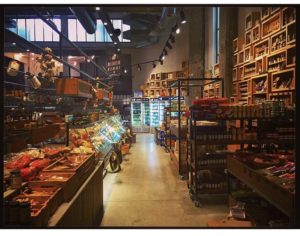
For a quick but delicious meal, I would have souvlaki (meat, cheese, or mushrooms grilled on a skewer, and served in pita bread) at Derlikatesen (7, Kouskoura Str.).
Desserts and patisseries
Thessaloniki is well-renowned for its desserts and patisseries. No wonder I have such a sweet tooth! In fact, most restaurants serve complimentary dessert (or fruit) at the end of a meal. As far as patisseries are concerned, Elenidis (13, Dimitriou Gounari Str). is famous for a dessert called trigono (triangle in Greek); this is a triangular-shaped pastry made with phyllo, soaked in syrup, and filled with custard. Hatzis (24, Mitropoleos Str.) is another patisserie, famous for traditional syrupy desserts (such as baklava) and other desserts originating from Constantinople and Asia Minor, whereas Konstantinidis (7 Pavlou Mela Str.) is renowned for the millefeuille (French dessert, but to die for).
Bars
Last but not least, there are hundreds of bars in Thessaloniki. I’ve already mentioned a few located on the waterfront (Kitchen Bar, High School Pizza Bar, Navona Day & Night, Omilos Bar Restaurant, Allegro). If, however, I was to pick one, that would be Enohes. It is housed in a neoclassical building at Navarinou Square (15, Platia Navarinou).
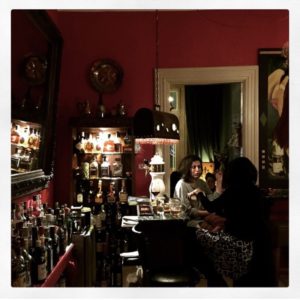
Where to go near Thessaloniki
Halkidiki and Mount Athos
If you visit Thessaloniki in the summer, then you will most likely combine your visit with a few days (or weeks) in Halkidiki (also spelled Chalkidiki), a peninsula on the southeast of Thessaloniki. On the map, Halkidiki resembles a hand with three fingers; two of these three smaller peninsulas (Kassandra and Sithonia) are very popular summer destinations for both Greeks and foreigners, whereas the easternmost (Mount Athos or Agion Oros) is an autonomous region, home to 20 monasteries. Access to Mount Athos is restricted and only adult male visitors are allowed to enter.
Having said that, there are guided tours (by boat, departing from Ouranoupoli, 130 km from Thessaloniki) that allow everyone to take a glimpse of the monasteries of the west coast of Mount Athos (albeit from some distance).
Kassandra and Sithonia, on the other hand, welcome everyone irrespective of gender, religion or ethnicity. The large number of beaches with their crystalline waters is the main reason for Halkidiki’s popularity. It therefore comes as no surprise that most visitors prefer the coastal villages, where most of the bars, restaurants, hotels and privately-owned summer houses are located; however, there are also a few inland villages and towns, where the locals stay. Kassandra is 70 km from Thessaloniki, Sithonia slightly further away.
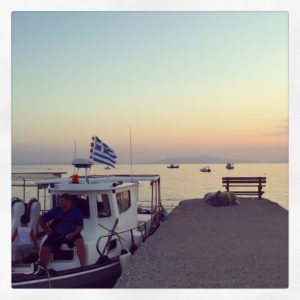
The archaeological site of Aigai (Vergina)
The ancient city of Aigai, the first capital of the Kingdom of Macedon, is basically where the modern town of Vergina is, 70 km west of Thessaloniki. The archaeological site of Aigai is a UNESCO World Heritage Site. A few decades ago, the burial sites of several kings of Macedon were found there, including the tomb of Philip II, father of Alexander the Great. The archeological site also contains the site of a royal palace, as well as an Archaeological Museum, with findings from the excavations.
Practical information
How to get to Thessaloniki
There are direct flights to Thessaloniki from many European airports, as well as daily flights to Athens and to many Greek islands, including Santorini, Mykonos and Skyros. There is a frequent bus service from the airport to the city center.
When and how long to visit Thessaloniki
Mid and late spring, as well as autumn, are probably the best times to visit Thessaloniki, as the weather is mild, not as hot as during the summer months, and not as cold as in the winter. As mentioned, there are many cultural events in September, whereas the Thessaloniki International Film Festival takes place in November. A couple of days may be enough to visit the main places of cultural and historical interest in the city, but if you combine your visit with a cultural event, or want to visit other places near Thessaloniki, you may wish to stay longer.
Accommodation in Thessaloniki
I would strongly recommend staying in the city center, first to avoid the dodgy parts of the city, and second to avoid taking public transport or taxis. Technically not in the city center, the iconic Macedonia Palace Hotel, is within walking distance, and worth considering if within your budget.
Alex
(the Traveling-again-Psychiatrist)